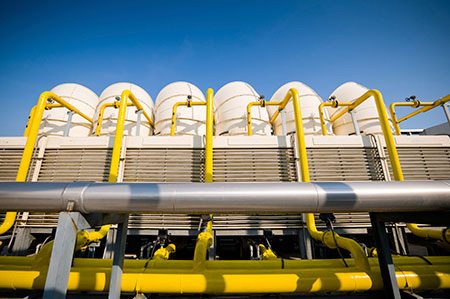What’s the most important part of your HVAC system?
 As with any large, complex piece of equipment, technical and human factors can alter performance. Small components can have an outsized impact on results: Moving parts need regular lubrication, for example, and filters need to be kept clean.
As with any large, complex piece of equipment, technical and human factors can alter performance. Small components can have an outsized impact on results: Moving parts need regular lubrication, for example, and filters need to be kept clean.
While many heating and cooling systems include a pump that works on similar principles, the pump in a commercial HVAC system is truly the workhorse that powers everything else. Pumps are essential for cooling towers, chillers, boilers, hydronic mechanical systems, and more.
The contributions a pump makes to overall performance often go unnoticed, however, since pumps used today are very similar to those that were in service twenty years ago. Other parts of the system have gone through dramatic changes to meet modern efficiency standards, but the modest pump remains largely unchanged in a reliable, conservative design.
As a result, facilities managers, architects, and designers have often overlooked the importance of the pump.
However, new changes in energy efficiency rules may soon change the situation.
Pumps Take Center Stage as U.S. Department of Energy Steps In
When it comes to energy efficiency standards, perhaps nobody throughout the nation has seen more changes or done more work than large commercial building teams in New York City.
The new regulatory climate brought on by the City’s “Greener, Greater Buildings Plan” and other initiatives has touched on every aspect of commercial building design and maintenance.
Though the changes have been profound, they are starting to yield results in energy savings and air quality – and they position facilities teams to react to unexpected shifts, such as the new Department of Energy ruling on pump efficiency.
Released in February, the Department’s final rule on pump efficiency is informative reading. It establishes a new efficiency standard, called the Pump Efficiency Index (PEI), which all pumps will have to meet.
Standards will differ greatly according to the size and configuration of the pump model, so you’ll need to determine your exact efficiency targets.
 The Department estimates that, as a result of the new standards, pumps purchased within the next 30 years will yield an overall savings of 0.29 quadrillion BTUs, about 1% of the total usage for pumps that don’t adhere to the new standards.
The Department estimates that, as a result of the new standards, pumps purchased within the next 30 years will yield an overall savings of 0.29 quadrillion BTUs, about 1% of the total usage for pumps that don’t adhere to the new standards.
New Standards are Coming: Time to Check Your Pumps
Although lower standards will be in place for some pumps, it’s essential to connect with commercial HVAC maintenance experts who can help you verify your responsibility under these complex new standards and take the steps you need to be compliant from day one.
Ensuring your HVAC system pump is well-maintained goes a long way toward meeting energy usage goals, cutting down the cost of ownership, and improving performance. Ideally, large commercial buildings should be covered by a preventive maintenance contract that aims to meet, or even exceed official performance guidelines.
